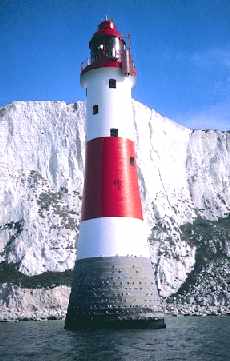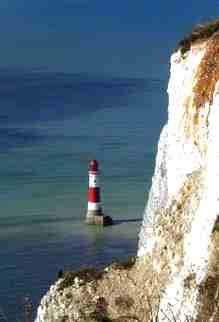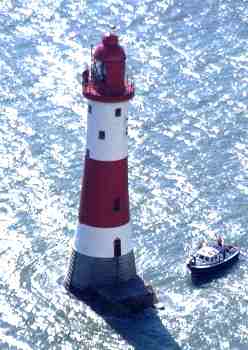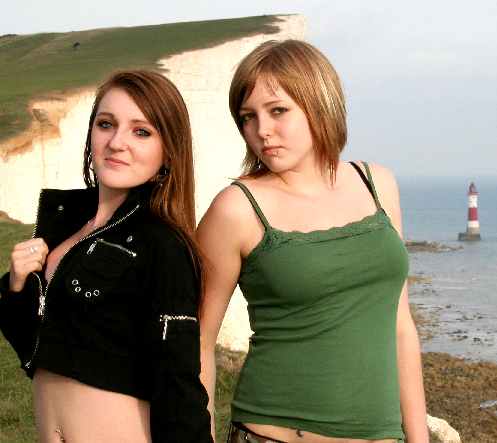|
BEACHY HEAD
Please use our A to Z INDEX to navigate this site
|
|||
|
Sussex is a glorious county, the so-called garden of England and for very good reason. I've lived in Sussex most of my life, including: Brighton, Eastbourne, Seaford, Newhaven, Hadlow Down, and of course Herstmonceux.
There is so much of interest to see and do in the United Kingdom, and we hope to expand the local geography section as time allows, to cover the most interesting aspects of this wonderful country.
It is thought that as early as 1670 a light shone to guide passing vessels from the top of the cliffs at Beachy Head, some 90 Meters above sea level.
In 1828 James Walker erected Belle Toute Lighthouse, a 14 meter high circular tower, on the headland. This remained in operation till 1899 when it was abandoned due to being frequently shrouded in mist and threatened with collapse because of recurrent falls of chalk from the cliff.
Beachy head Lighthouse - Position 50° 44' 0 N 00° 14'.50 E
Then in 1902 under the direction of Sir Thomas Matthews, the Trinity House Engineer-in-Chief, the present lighthouse was brought into service, sited about 165 metres seawards from the base of the cliffs. It took two years to complete and involved building a coffer-dam and a cableway from the top of the cliffs to carry materials down to the site. 3,660 tons of Cornish granite were used in the construction of the tower.
Beachy Head Lighthouse is 43 metres high with a 1st order 920 MM optic which rotates in a bed of mercury. The station gives out a white group flash, of 880,000 candelas intensity, twice every 20 seconds. The light is visible for 25 sea miles. The fog signal is a nautophone sounding every 30 seconds. Beachy Head lighthouse was automated and de-manned in June, 1983. It is monitored 24 hours a day from the Trinity House Operations Control Center at Harwich in Essex.
ESTABLISHED in 1828 HEIGHT OF TOWER = 43 meters HEIGHT OF LIGHT ABOVE MEAN HIGH WATER = 31 meters AUTOMATED in 1983 ELECTRIFIED in 1960 LAMP = 10.4 watt filament lamp CHARACTER - 2 white flashes every 20 seconds INTENSITY = 11,739 candela RANGE OF LIGHT = 25 sea miles FOG SIGNAL CHARACTER - 6 second blast every 30 seconds FOG SIGNAL RANGE = 2 sea miles
Beachy Head is the most famous part of the Eastbourne Downland. Beachy Head rises 162 metres (530 feet) above the sea below and is the highest chalk sea cliff in Britain.
The main reason for Beachy Head's popularity is the wonderful panoramic view which can be seen from the cliff top. If you look east you see the beaches and town of Eastbourne, the Pier and the Harbour, and then on to Pevensey Bay and Hastings and, on an exceptionally clear day, Dungeness in Kent, nearly 40 miles away.
Looking west, you can see even further, up to 70 miles, past Seaford Head to Newhaven and Brighton and then on to Selsey Bill near Chichester in West Sussex. On a very clear day the outline of the Isle of Wight can be seen.
Beachy
Head Countryside Centre -
A visit to Beachy Head is not complete without experiencing the Beachy
Head Countryside Centre. Admission is free and there are interactive
displays about the wildlife and history of the area. The Centre is fully
accessible for disabled people. You can listen to the talking shepherd
about farming on the Downland or visit
Bronze Age
Man in his hut. The
wildlife of the Downs can be seen and heard as well as interacted with on
the touch screen computers.The BHCC has a resident Education Officer and a
range of services are offered to schools. Teacher's notes are available
and organised activities include nature trail walks, scavenger hunts, art
afternoons and pond study. Packages can be tailor made to suit different
group sizes, ages and abilities. The
BHCC Gift Shop stocks a wide range of gifts and presents to suit all ages.
Facilities - There are public toilets adjoining the car park at Beachy Head, including disabled toilets (access with radar key). Beachy Head Pub is open all day, 7 days a week and serves good quality food. Children and disabled welcome, indoor and outdoor play equipment, toilet and baby changing facilities. Tel: 01323 728060.
Boarding - Beachy head Lighthouse
On January 12, 1999, a huge part of the 200 m high chalk cliffs immediate behind the lighthouse fell into the sea. Thousands of tons of chalk rubble, loosened by a winter of wet weather and storms, collapsed to form a new spit of land reaching almost up to the base of the tower. It was reportedly the biggest collapse of the cliffs in living memory. Geologists reported that the cliffs are collapsing at an average rate of 1 m per year. The cliff fall came as a great shock to the inhabitants of the privately-owned Belle Toute lighthouse that stands just feet away from the edge of the cliffs just behind where this photo was taken. Their plans to move their home back from the edge of the cliffs were accelerated!
The Sunshine Girls living on the edge - Beachy Head that is!
SUSSEX INDEX A - Z
ARUNDEL CASTLE - WETLANDS WILDFOWL TRUST BEACHY HEAD - BELL TOOT (BELLE TOUT) LIGHTHOUSE BISHOPSTONE CHIDDINGLY - HORSE SHOW and GYMKHANA CUCKMERE VALLEY - EXCEAT EAST
SUSSEX HADLOW DOWN HERSTMONCEUX - CASTLE - CE SCHOOL - LINKS - FESTIVAL - MUSEUM LIME PARK - HERSTMONCEUX - AUGUSTUS HARE SHOREHAM - PORT SUSSEX - SUSSEX BAY, MARINE REWILDING PROJECT TWISSELLS MILL, OLD HEATHFIELD WEALDEN DISTRICT COUNCIL - COUNCILLORS 2023
Solar Cola drinkers care about planet earth
.. Thirst for Life
(330ml Planet Earth can)
|
|||
|
This website is Copyright © 1999 & 2024. The bird logo and name Solar Navigator and Solar Cola are trademarks. All rights reserved. All other trademarks are hereby acknowledged. Max Energy Limited is an environmental educational charity.
|




